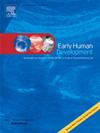Prenatal exercise regulates influence of parental body mass index on birth outcomes
IF 2.2
3区 医学
Q2 OBSTETRICS & GYNECOLOGY
引用次数: 0
Abstract
Background
Offspring body mass index is often higher in parents with overweight or obesity, thereby increasing the risk of obesity later in life. As data has shown that exercise during pregnancy reduces gestational weight gain and offspring adiposity, we believe the intergenerational risk of obesity could be reduced.
Objective
This study aimed to test the influence of paternal and maternal overweight or obesity on neonatal body mass index and other birth measures, and whether exercise during pregnancy would improve outcomes.
Methods
Prenatal exercise (aerobic, resistance, or combination) was provided as a supervised exercise intervention throughout pregnancy. Pre-pregnancy body mass index was reported by mothers and fathers at enrollment. Gestational age (GA), neonatal resting heart rate (rHR), morphometrics (body circumferences, weight-to-length, body mass index), Apgar, and reflex scores were obtained at birth. Independent samples t-tests assessed the effect of exercise, while one-way ANOVA was used to detect group differences. Pearson product-moment correlations tested the intergenerational relationship of body mass index.
Results
Birth outcomes were obtained for 220 women (CON: 62, AE: 68, RE: 39, AERE: 51). Women participated in exercise for an average of 17 weeks during pregnancy. Birth weight tended to be higher in offspring born to 1 or 2 parents with overweight or obesity (p = .07), thereby increasing birth weight-length ratio (p = .05). BMI was reduced for neonates born to exercising mothers (p = .08) and fathers with OB.
Conclusion
These data suggest exercise during pregnancy could prevent the intergenerational cycle of obesity from parent to offspring.
产前运动调节父母体重指数对出生结局的影响
背景超重或肥胖的父母的后代体重指数通常更高,从而增加了日后肥胖的风险。数据显示,怀孕期间的运动可以减少妊娠期体重增加和后代肥胖,我们相信肥胖的代际风险可以降低。目的本研究旨在测试父亲和母亲超重或肥胖对新生儿体重指数和其他出生指标的影响,以及孕期运动是否会改善结局。方法将产前运动(有氧运动、阻力运动或联合运动)作为妊娠期间的监督运动干预。母亲和父亲在入组时报告了孕前体重指数。出生时获得胎龄(GA)、新生儿静息心率(rHR)、形态测量(体围、体重比、体重指数)、Apgar和反射评分。独立样本t检验评估运动的影响,而单因素方差分析用于检测组间差异。Pearson积差相关性检验了体质指数的代际关系。结果220例妇女获得分娩结局(对照组62例,AE 68例,RE 39例,AE 51例)。女性在怀孕期间平均锻炼17周。父母一方或双方均超重或肥胖者所生子女的出生体重往往较高(p = .07),从而增加了出生重长比(p = .05)。运动的母亲和患有ob的父亲所生的新生儿的体重指数降低(p = .08)。结论这些数据表明,在怀孕期间运动可以防止父母到后代的肥胖代际循环。
本文章由计算机程序翻译,如有差异,请以英文原文为准。
求助全文
约1分钟内获得全文
求助全文
来源期刊

Early human development
医学-妇产科学
CiteScore
4.40
自引率
4.00%
发文量
100
审稿时长
46 days
期刊介绍:
Established as an authoritative, highly cited voice on early human development, Early Human Development provides a unique opportunity for researchers and clinicians to bridge the communication gap between disciplines. Creating a forum for the productive exchange of ideas concerning early human growth and development, the journal publishes original research and clinical papers with particular emphasis on the continuum between fetal life and the perinatal period; aspects of postnatal growth influenced by early events; and the safeguarding of the quality of human survival.
The first comprehensive and interdisciplinary journal in this area of growing importance, Early Human Development offers pertinent contributions to the following subject areas:
Fetology; perinatology; pediatrics; growth and development; obstetrics; reproduction and fertility; epidemiology; behavioural sciences; nutrition and metabolism; teratology; neurology; brain biology; developmental psychology and screening.
 求助内容:
求助内容: 应助结果提醒方式:
应助结果提醒方式:


